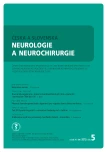A Strategy for Diagnosis, Therapy and Follow-up of Patiens with CNS Haemangioblastoma from the Perspective of a Neurosurgeon
Authors:
O. Kalita 1; M. Vaverka 1; L. Hrabálek 1; M. Zlevorová 2; A. Šantavá 3; A. Křepelová 4; J. Ehrmann Jr 5; E. Čecháková 6
Authors‘ workplace:
Neurochirurgická klinika LF UP a FN Olomouc
1; Onkologická klinika LF UP a FN Olomouc
2; Oddělení klinické genetiky LF UP a FN Olomouc
3; Ústav biologie a lékařské genetiky 2. LF UK a FN v Motole, Praha
4; Laboratoř molekulární patologie, Oddělení patologie LF UP a FN Olomouc, Ústav molekulární a translační medicíny (BIOMEDREG)
5; Radiologická klinika LF UP a FN Olomouc
6
Published in:
Cesk Slov Neurol N 2013; 76/109(5): 623-629
Category:
Short Communication
Overview
The aim of our study
was to establish a strategy of diagnosis, treatment and follow-up of patients after surgery for CNS haemangioblastoma (HB) and to evaluate its use in our group of patients. Primarily, it was necessary to distinguish between patients with sporadic HBs and those with von Hippel-Lindau disease (mVHL). Originally, the diagnosis of this genetically transmitted disease was made based on clinical findings only, including a combination ofHB presence and mVHL-associated tumours and both familiar and multilocal or recurrent HBs. This diagnostic approach resulted in many false positive as well as false negative conclusions. The introduction of VHL gene DNA analysis into clinical practice facilitated unequivocal identification of patients with mVHL. We then focused on patient screening. If mVHL was not proved and post-surgical MRI was negative, no further follow-up was indicated. In the presence of positive germinal VHL gene mutation and absence of other CNS lesions, MRI was repeated every 12 months. In case of newly identified CNS HBs not indicated for surgery, MRI is performed and surgical treatment reconsidered every six months. It depends on the patient’s clinical condition, cyst and solid tumour volume and, in particular, on tumour location. Clinical signs are also influenced by neoplasm growth rate and character. This strategy has been extrapolated to mVHL-associated extraneuronal tumours. CNS HB was the only manifestation in a substantial number of patients with confirmed VHL gene mutation. Surgical approach tumour location and characteristics are of major importance. A DNA analysis-based follow-up strategy was designed and applied to all patients with histologically verified HB. The goal is to detect other signs of mVHL before they are manifested clinically.
Key words:
haemangioblastoma – von Hippel‑ Lindau disease – genetic testing
The authors declare they have no potential conflicts of interest concerning drugs, products, or services used in the study.
The Editorial Board declares that the manuscript met the ICMJE “uniform requirements” for biomedical papers.
Sources
1. Plate KH, Vortmeyer AO, Zagzag D, Neumann HP. Von Hippel‑ Lindau disease and haemangioblastoma. In: Louis DN, Ohgaki H, Otmar D et al (eds). WHO Classfication of Tumours of the Central Nervous System. Lyon: IARC Press 2007: 215– 217.
2. Sanberg AA, Stone JF. Haemangioblastoma of the Central Nervous system. In: Sanberg AA, Stone JF (eds). The Genetics and Molecular Biology of Neural Tumors. Totowa, NJ: Humana Press 2008: 145– 164.
3. Jagannathan J, Lonser RR, Smith R, deVroom HL, Oldfield EH. Surgical management of cerebellar hemangioblastomas in patients with von Hippel‑ Lindau disease. J Neurosurg 2008; 108(2): 210– 222.
4. Ammerman JM, Lonser RR, Dambrosia J, Butan JA, Oldfield EH. Long‑term natural history of hemangioblastomas in patients with von Hippel‑ Lindau disease: implications for treatment. J Neurosurgery 2006; 105(2): 248– 255.
5. Ortego‑ Martínez M, Cabezudo FM, Fernández‑ Portales I, Pineda‑ Palomo M, Rodrígues‑ Sánches JA, Bernal‑ García LM. Multiple filum terminale hemangioblastomas symptomatic dutiny pregnancy. Case report. J Neurosurg Spine 2007; 7(2): 254– 258.
6. Niemelä M, Lemeta S, Summanen P, Böhling T, Sainio M, Kere J et al. Long‑term prognosis of haemangioblastoma of the CNS: impact of von Hippel‑ Lindau disease. Acta Neurochir 1999; 141(11): 1147– 1156.
7. Přibáň V, Fiedler J, Řehoušek P, Štěrba L, Štěpánková H, Křepelová A. Kombinovaná mikrochirurgická a endovaskulární terapie intramedulárního hemangioblastomu: kasuistika. Cesk Slov Neurol N 2007; 70/ 103(5): 580– 583.
8. Roonprapunt C, Silvera VM, Setton A, Freed D, Epstein FJ, Jallo GI. Surgical management of isolated haemangioblastomas of the spinal cord. Neurosurgery 2001; 49(2): 321– 328.
9. Symon L, Murota T, Pell M, Bordi L. Surgical management of haemangioblastoma of the posterior fossa. Acta Neurochir 1993; 120(3– 4): 103– 110.
10. Shin DA, Kim SH, Kim KN, Shin HC, Yoon DH. Surgical management of spinal cord haemangioblastoma. Acta Neurochir 2008; 150(3): 215– 220.
11. Zhou LF, Du G, Mao Y, Zhang R. Diagnosis and surgical treatment of brainstem hemangioblastomas. Surg Neurol 2005; 63(4): 307– 315.
12. Pietilä TA, Stendel R, Schilling A, Krznaric I, Brock M. Surgical treatment of spinal hemangioblastomas. Acta Neurochir 2000; 142(8): 879– 886.
13. Asthagiri AR, Mehta GU, Zach L, Li X, Butman JA, Camphausen KA, Lonser RR. Prospective evaluation of radiosurgery for hemangioblastomas in von Hippel‑ Lindau disease. Neuro Oncol 2010; 12(1): 80– 86.
14. Valchář J, Liščák R, Šimonová G, Vymazal J. Hemangioblastom a jeho léčba pomocí Leksellova gama nože. Cesk Slov Neurol N 2008; 71/ 104(2): 216– 222.
15. Simone CB jr, Lonser RR, Ondos J, Oldfield EH, Camphausen K, Simone NL. Infratentorial craniospinal irradiation for von Hippel‑ Lindau: a retrospective study supporting a new treatment for patients with CNS hemangioblastomas. Neuro Oncol 2011; 13(9): 1030– 1036.
16. Smrcka M, Smrcka V. CNS haemangioblastoma: its role in von Hippel‑ Lindau disease. Bratisl Lek Listy 2000; 101(9): 503– 506.
17. Plevová P, Novotný J, Křepelová A. Von Hippel‑ Lindauova choroba. Klin Onkol 2009; 22 (Suppl): 23– 24.
Labels
Paediatric neurology Neurosurgery NeurologyArticle was published in
Czech and Slovak Neurology and Neurosurgery

2013 Issue 5
Most read in this issue
- Wilson Disease
- Glioblastoma Multiforme – a Review of Pathogenesis, Biomarkers and Therapeutic Perspectives
- Tumefactive Variant of Multiple Sclerosis – Two Case Reports
- The 3F Test Dysarthric Profile – Normative Speach Values in Czech
